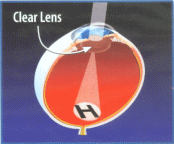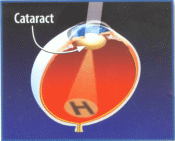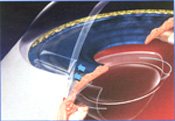
Over fifty percent of people over the age of 60, and quite a few younger, suffer from cataracts. In fact, cataracts are so common, it is said that everyone will develop a cataract if they live long enough.
A cataract is a progressive clouding of the eye's natural lens that interferes with light passing through to the retina, which lies behind the iris and the pupil. Sufferers usually describe the condition as being similar to looking through a waterfall, or a piece of wax paper, with a gradual blurring or dimming of vision. 
TREATING A CATARACT
Because there is no medical treatment for cataracts (the browning and clouding of your natural lens), the option often utilized is the removal of the natural lens of the eye, and in most cases, replacing it with a tiny, man-made lens that is inserted into your eye to restore vision. The man-made lens is called an intraocular lens, or IOL for short.
According to a survey conducted by the American Society of Cataract and Refractive Surgery, more than 98% of cataract patients had their vision successfully improved after surgery. Once removed, cataracts will not grow back. The results of the surgery are permanent, giving patients a lifetime of better vision. Soon you will notice a cataract is something you definitely can live without!
TREATING PRESBYOPIA
The same type of procedure can be used to treat presbyopia, which is a condition that reduces the eye's ability to switch from one focal point (objects at a distance) to another focal point (objects that are near).  Presbyopia usually becomes most noticeable when an individual finds it more difficult to see or read objects that are close. Glasses or bifocals are one solution to this problem, but for those desiring independence from glasses, removal of the eye's natural lens and replacing it with an IOL can be an attractive solution.
Presbyopia usually becomes most noticeable when an individual finds it more difficult to see or read objects that are close. Glasses or bifocals are one solution to this problem, but for those desiring independence from glasses, removal of the eye's natural lens and replacing it with an IOL can be an attractive solution.
Today's treatment is faster and more comfortable than ever, and millions of people worldwide are now enjoying excellent vision as a result of their surgical procedures.
THE PROCEDURE
Today, cataract removal is generally performed as an outpatient procedure under local or topical anesthesia. You will be fully awake, but you will be comfortable and feel no pain.
Typically, you will be asked to arrive an hour or so prior to your procedure, and you will be allowed to leave after a period of observation following your procedure. With the cataract removal process lasting only about 20 minutes, the entire procedure -- from entering the operating facility to returning home -- usually takes only a few hours.
To remove your cataract (clouded lens), your doctor will use a technique called phacoemulsification (phaco). Your doctor will make a tiny, 1/8-inch incision and insert a small phaco probe. The probe will break apart the clouded lens and suction it out.
Next, an IOL will be inserted through the same tiny incision, into the lens capsule of your eye. Because this procedure is performed through an incision that is very small, your eye will be able to heal rapidly with little or no discomfort.
Topical anesthesia and self-healing incisions have taken cataract surgery to the next level. Many patients are able to see with clear vision much sooner after the surgery. In most cases, it is now possible to return to daily activities, such as driving and reading, almost immediately.
Following the procedure, you will be allowed to return home within an hour or so. In most cases you will notice an immediate improvement in vision. Different people learn to use their new vision system at different rates.










